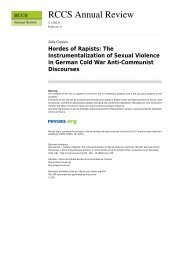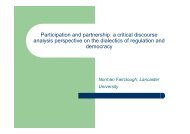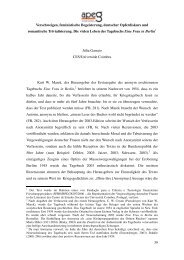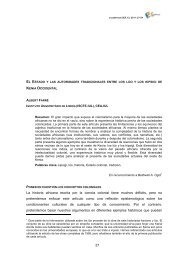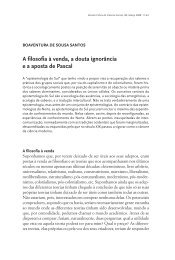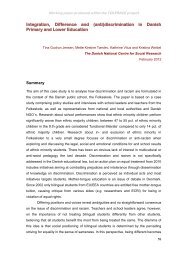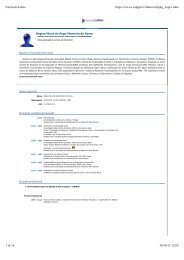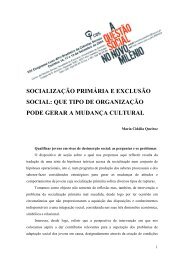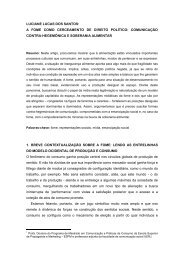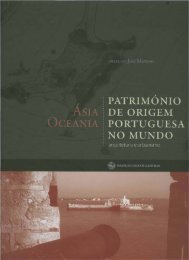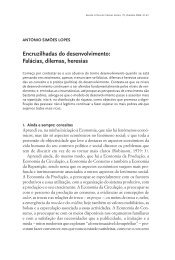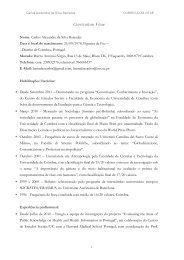Analysis of Integration Policies and Public State-Endorsed ...
Analysis of Integration Policies and Public State-Endorsed ...
Analysis of Integration Policies and Public State-Endorsed ...
You also want an ePaper? Increase the reach of your titles
YUMPU automatically turns print PDFs into web optimized ePapers that Google loves.
Working paper produced within the TOLERACE project<br />
1. Description <strong>and</strong> historicity <strong>of</strong> the institutions<br />
Immigration to Denmark is not a new phenomenon. Until recently, however,<br />
immigration flows were moderate, <strong>and</strong> most immigrants came from other Nordic or<br />
Western countries. This changed in the 1960s where a growing number <strong>of</strong> immigrants<br />
mainly from Ex-Yugoslavia, Turkey <strong>and</strong> Pakistan, came to Denmark to work. In 1973,<br />
the government tried to put a stop to immigration from non-Western countries,<br />
but new immigrants have continued to arrive – primarily as a result <strong>of</strong> family<br />
reunifications <strong>and</strong> asylum. Furthermore, regional conflicts, the breakdown <strong>of</strong> empires<br />
<strong>and</strong> federations, <strong>and</strong> conflicts in the Middle East have led to the arrival <strong>of</strong> several new<br />
groups <strong>of</strong> refugees during the 1980s <strong>and</strong> 1990s (Hedet<strong>of</strong>t, 2006b). Today, immigrants<br />
<strong>of</strong> non-Western countries constitute about six per cent <strong>of</strong> the Danish population, <strong>and</strong><br />
the focus on integration <strong>and</strong> on how to manage cultural diversity in Danish society <strong>and</strong><br />
politics is greater than ever (Danish Immigration Service, 2009). Since 2001 a new<br />
immigration pattern has emerged as the number <strong>of</strong> immigrants coming to Denmark to<br />
work or study has increased significantly (including immigrants from EU/EEA<br />
countries), whereas the number <strong>of</strong> refugees <strong>and</strong> family reunifications has been reduced<br />
to almost a third <strong>of</strong> the count in 2001 (Danish Immigration Service 2010, 2004).<br />
<strong>Integration</strong> as a particular issue has been a declared objective in Danish<br />
policy since the 1980s, <strong>and</strong> in 1983 a new foreigners‘ law was introduced along with a<br />
―Memor<strong>and</strong>um on Migration policy‖. A specific integration law, however, was not<br />
formulated before 1999, being the first <strong>of</strong> its kind in a Western country. The law led to<br />
some changes in the organisation <strong>and</strong> implementation <strong>of</strong> the integration policy. The<br />
municipalities were assigned the main responsibility for carrying out the<br />
objectives <strong>of</strong> the integration policy. Previously, the task had been divided between<br />
the municipalities <strong>and</strong> the Danish Refugee Aid organization, but to improve the<br />
management <strong>and</strong> coordination <strong>of</strong> the integration process, all the separate elements<br />
were now gathered under the same political authority. For the same reason, <strong>and</strong> in<br />
order to strengthen the focus on integration issues, a new Ministry for Refugees,<br />
Immigrants <strong>and</strong> <strong>Integration</strong> was established in 2001. The Ministry took over tasks that<br />
had previously belonged to the Ministry <strong>of</strong> Interior, <strong>and</strong> was assigned responsibility for<br />
e.g. the Aliens Act <strong>and</strong> the <strong>Integration</strong> Act, statistics on foreigners, ethnic equality, <strong>and</strong><br />
instruction in Danish language <strong>and</strong> civics. With the establishment <strong>of</strong> the new ministry,<br />
most issues related to integration are now gathered under one ro<strong>of</strong> (Hedet<strong>of</strong>t, 2006b).<br />
In 1997, The Board <strong>of</strong> Ethnic Equal Treatment was established m<strong>and</strong>ated by<br />
54



